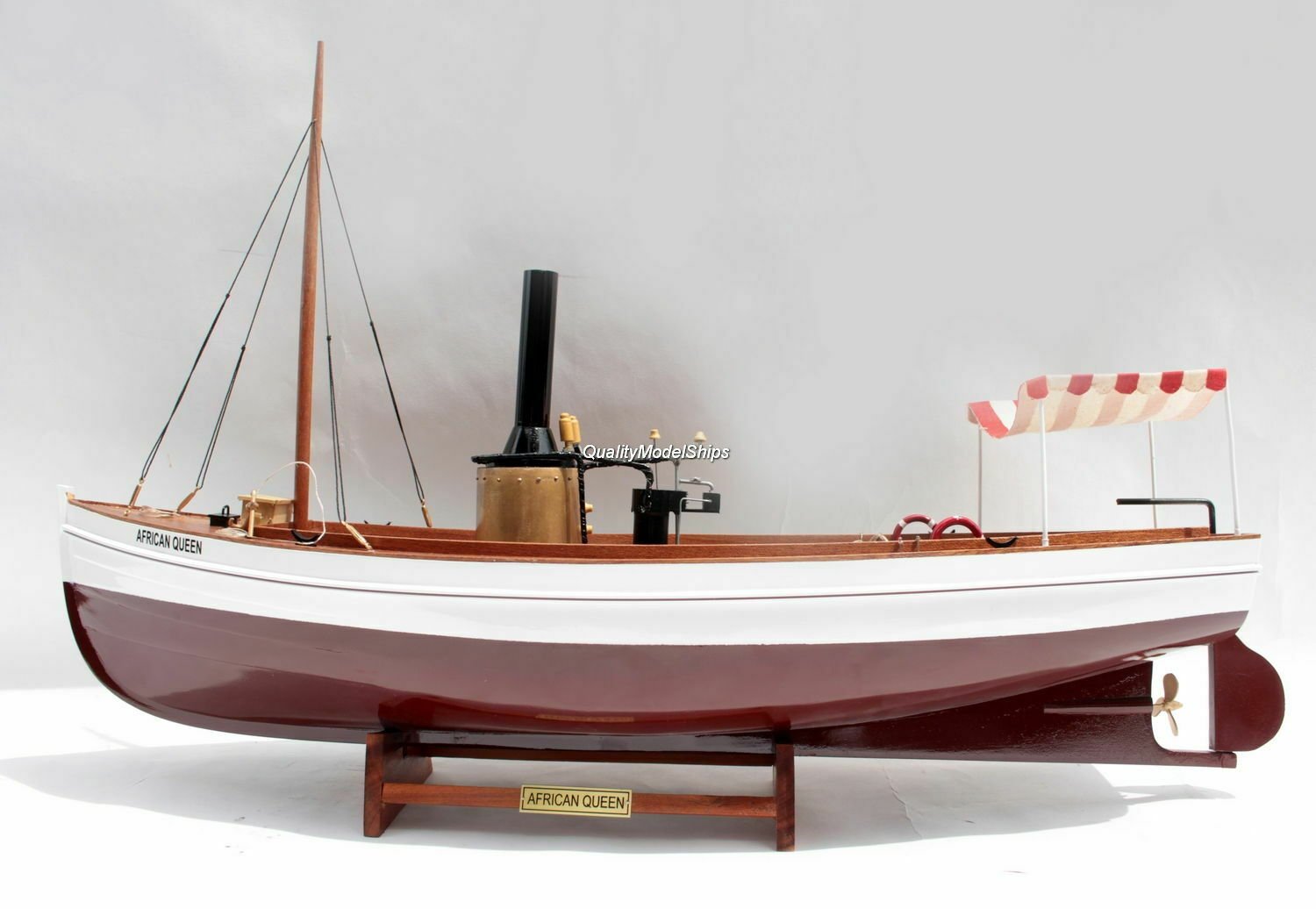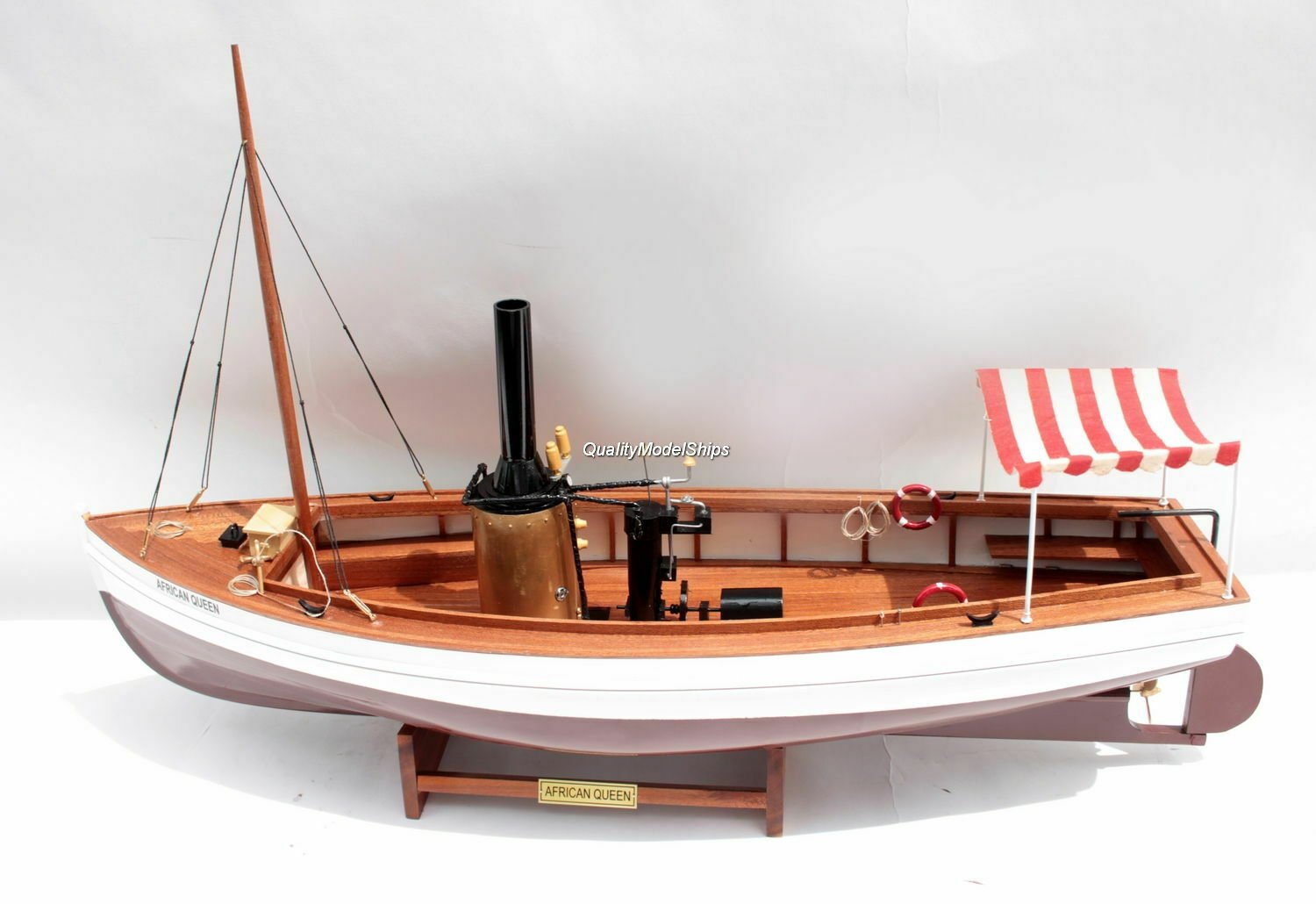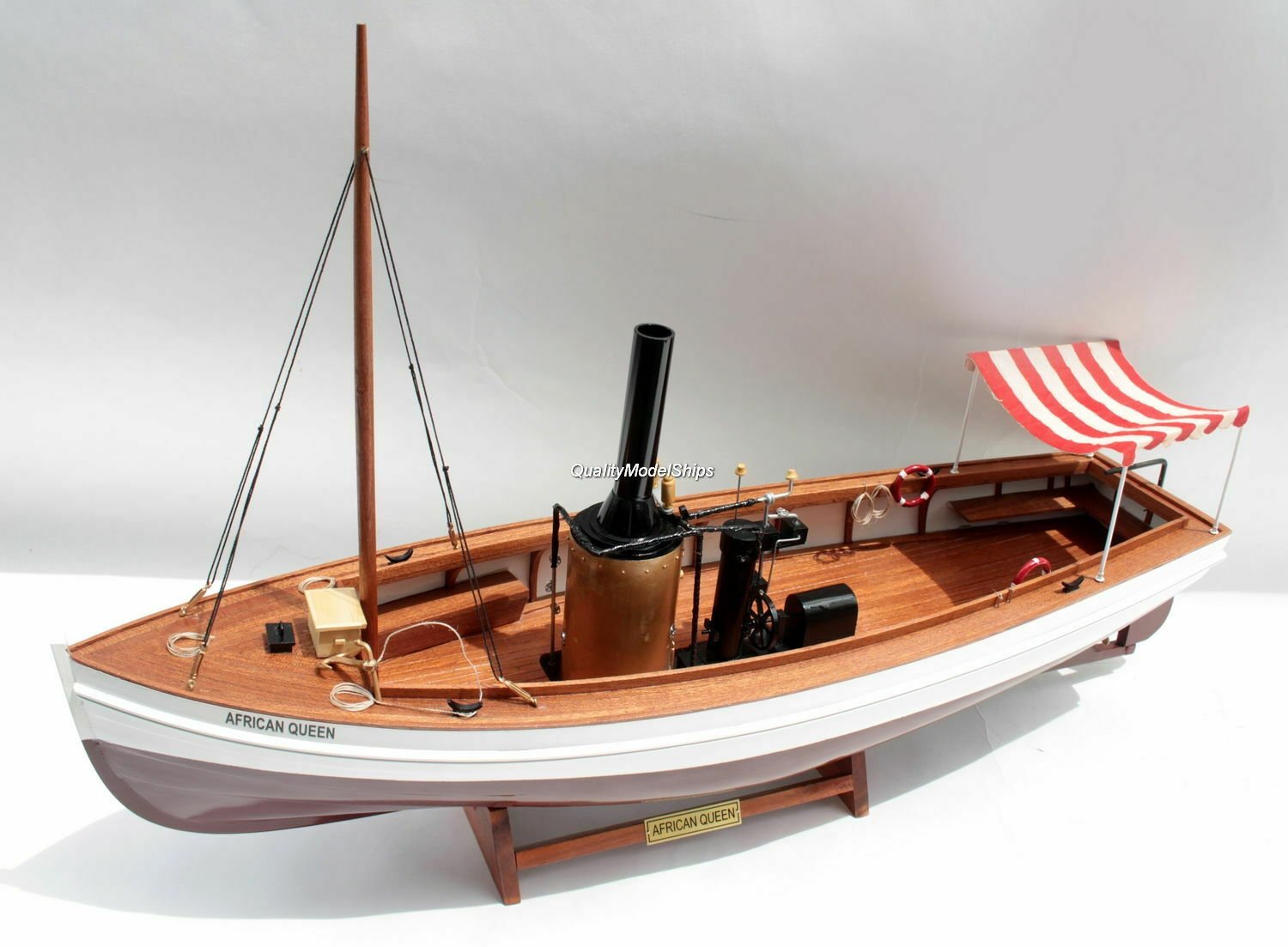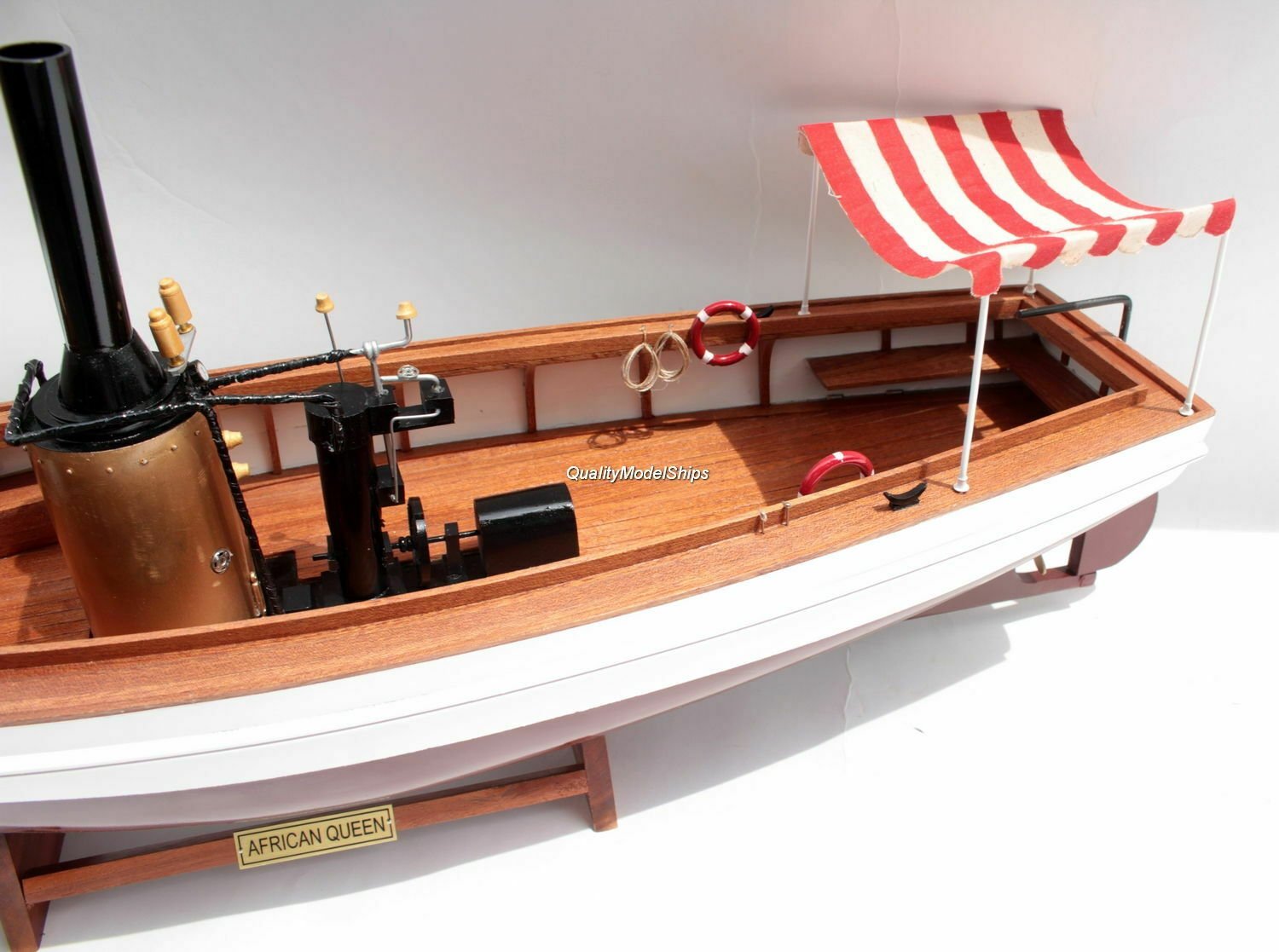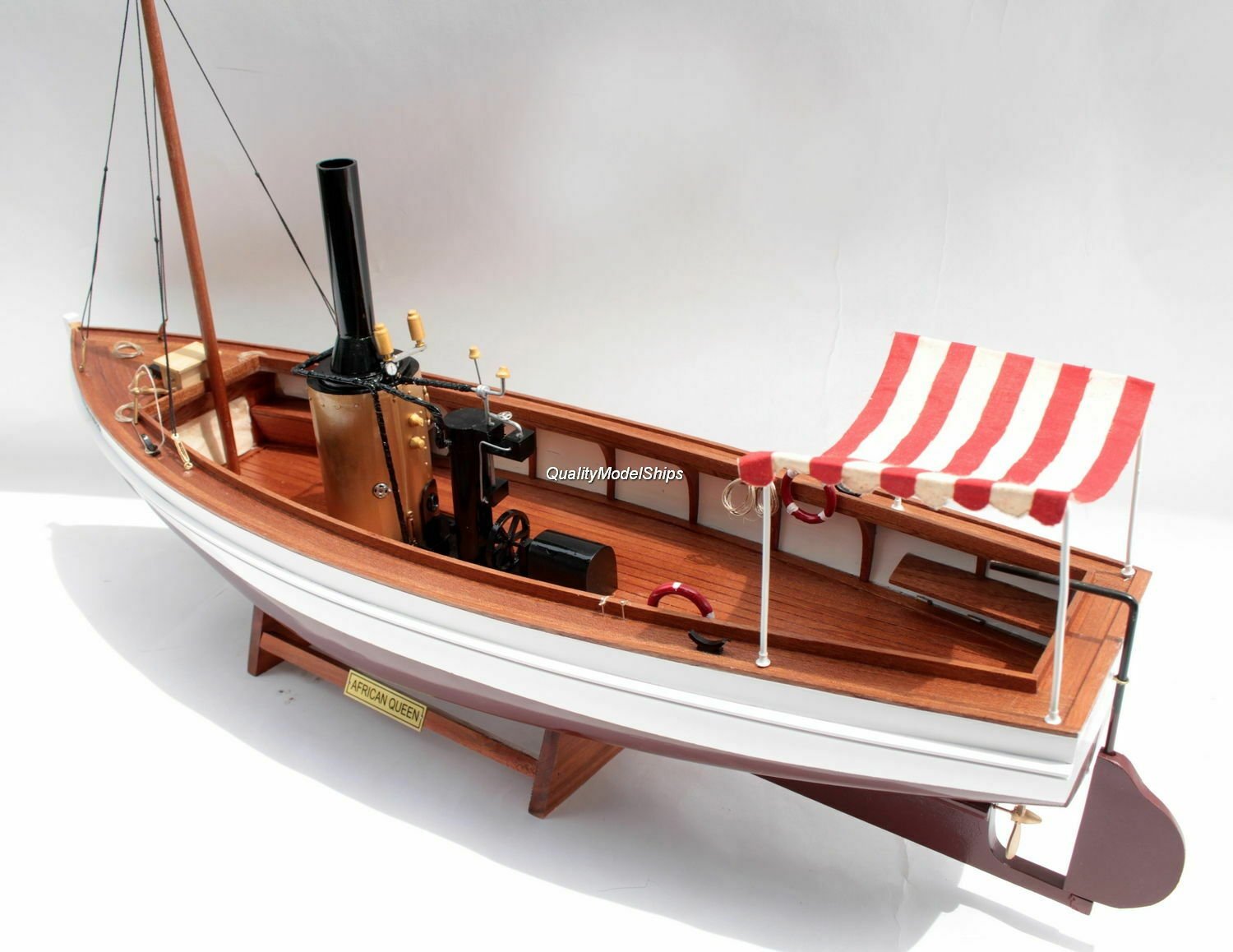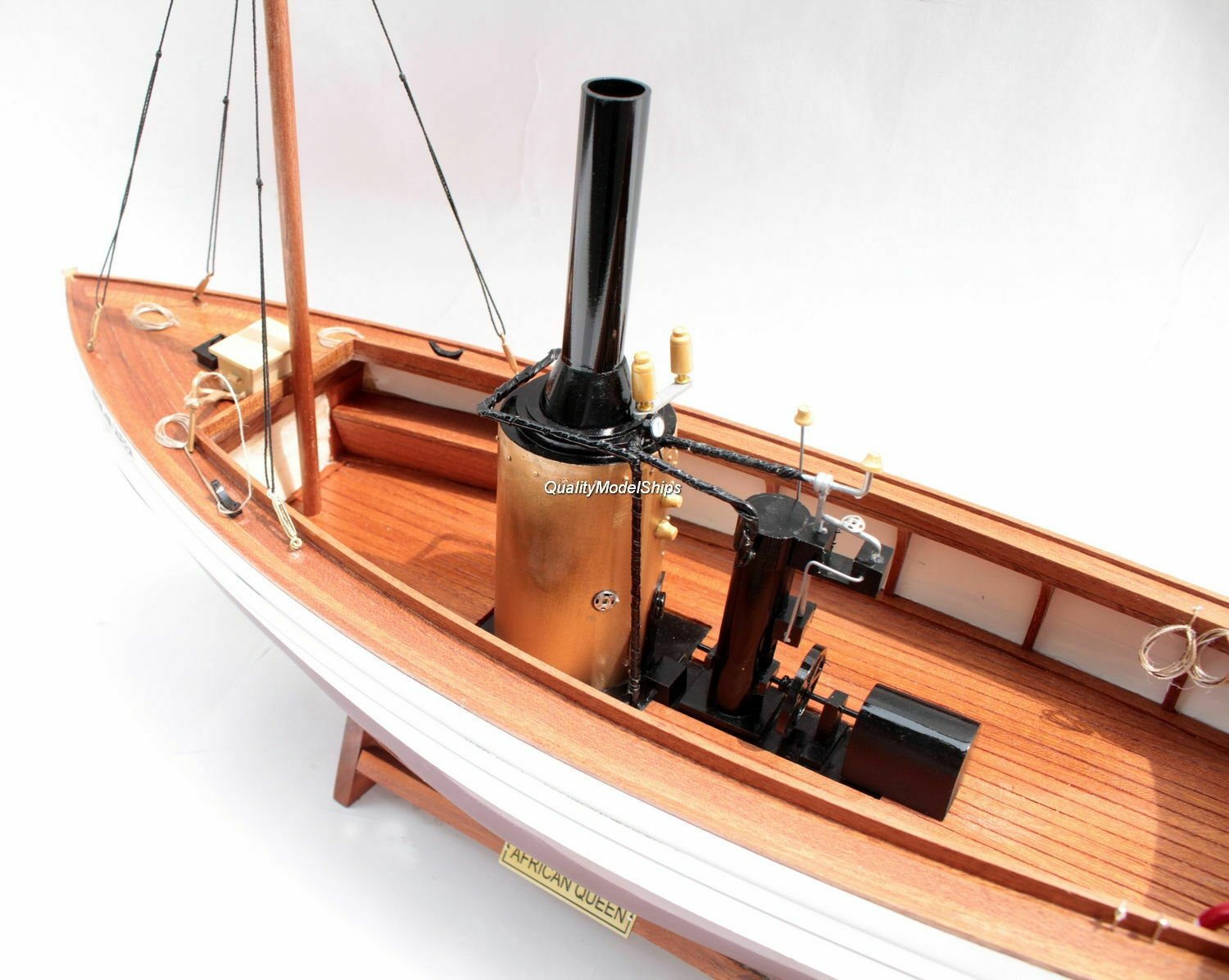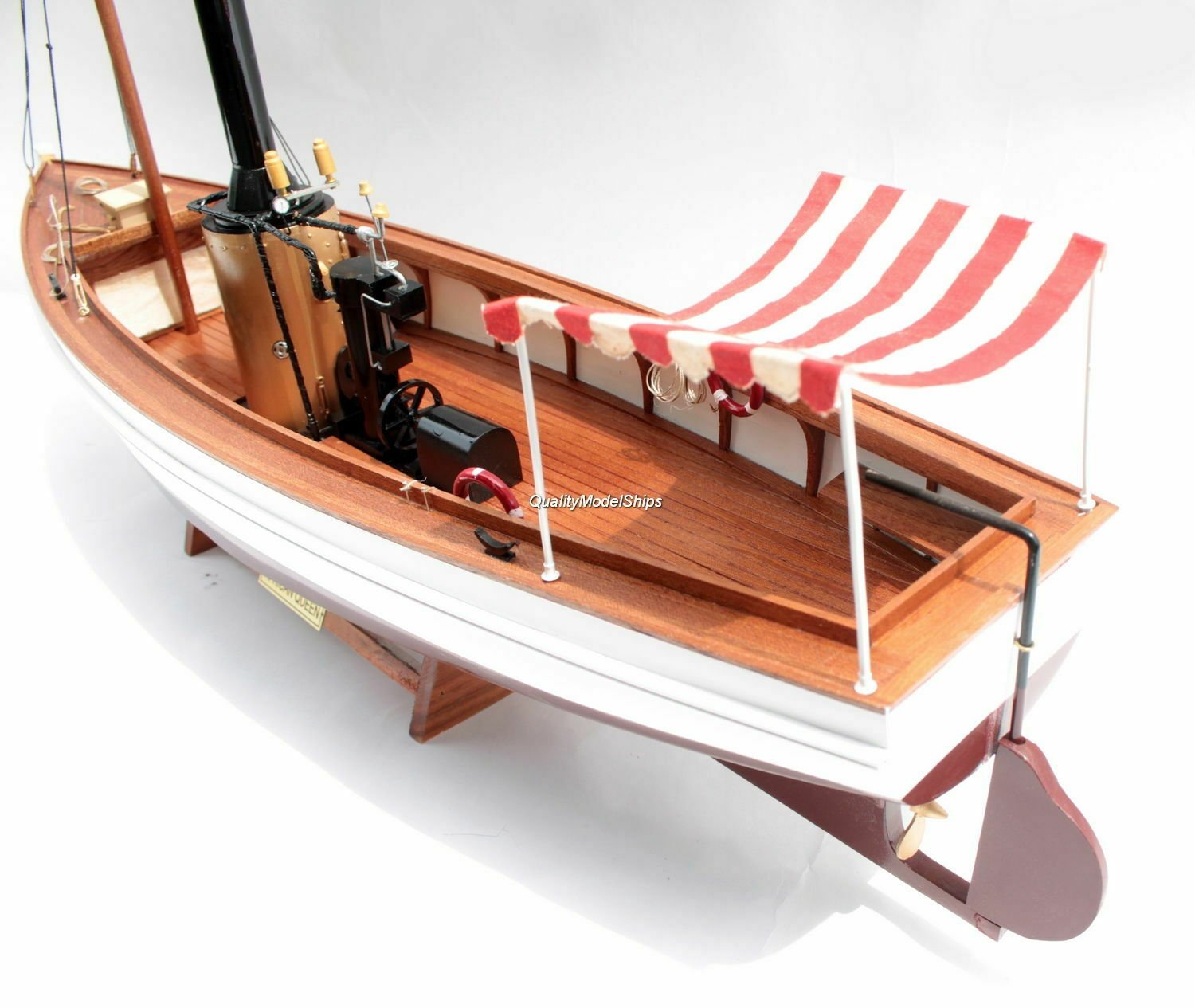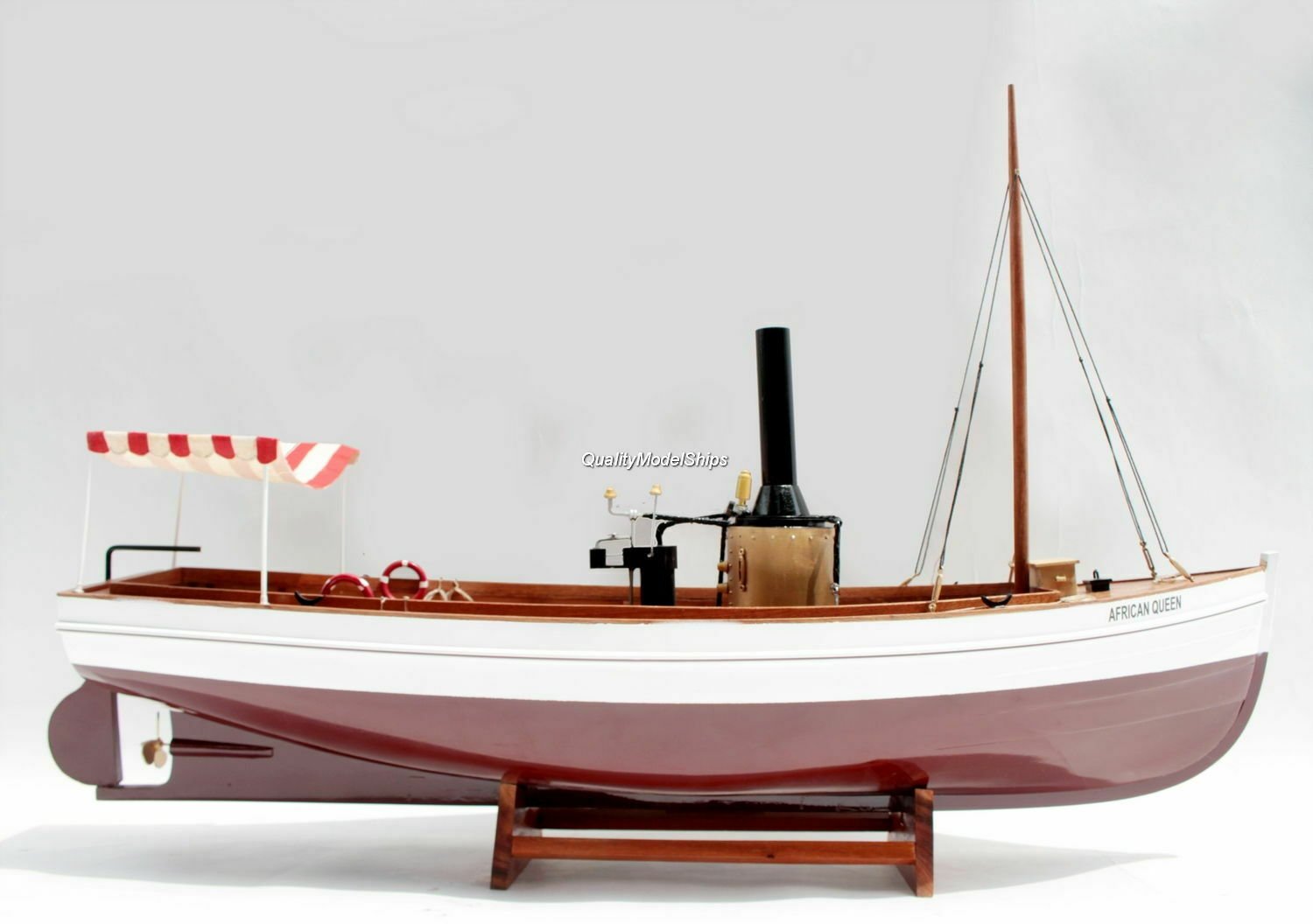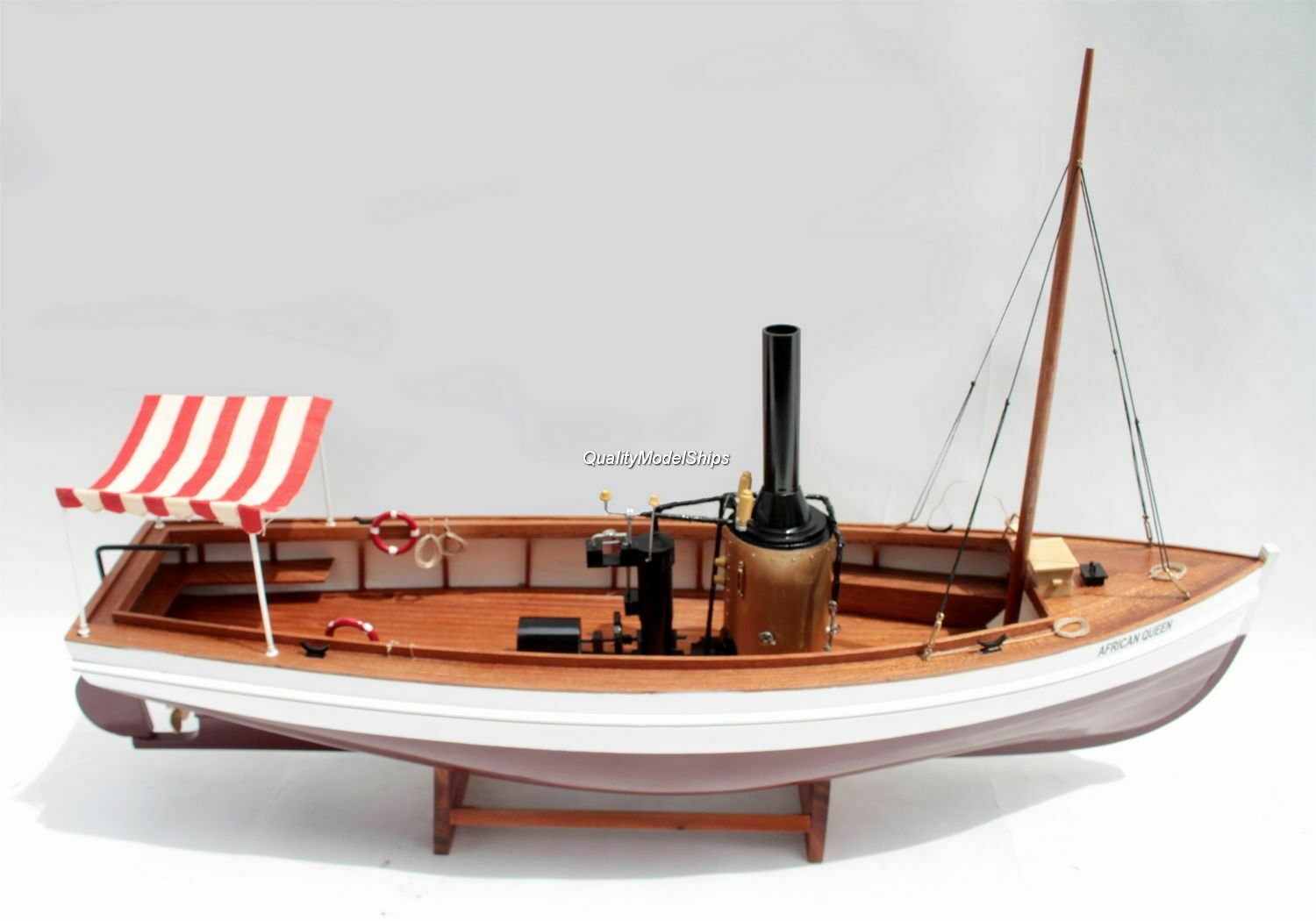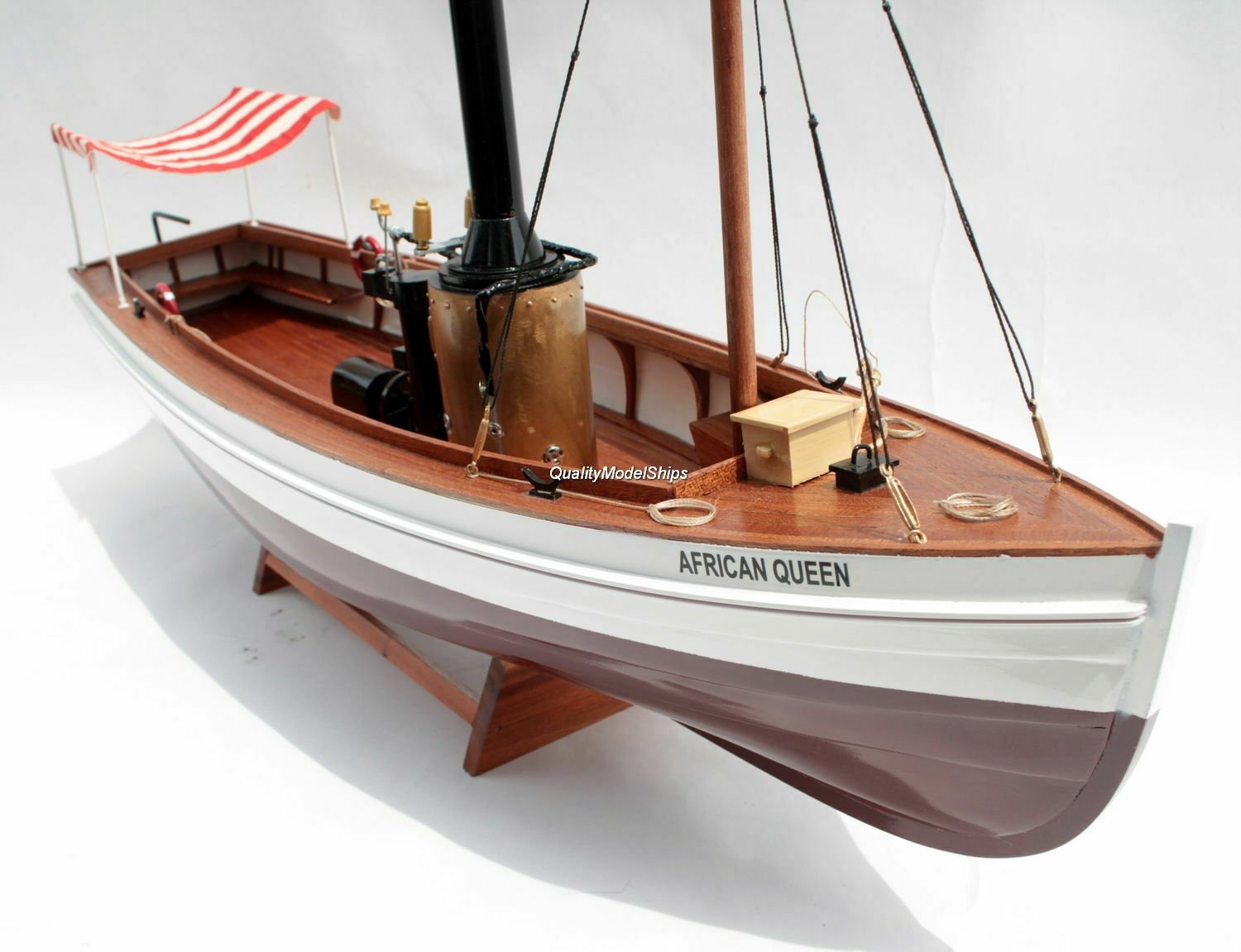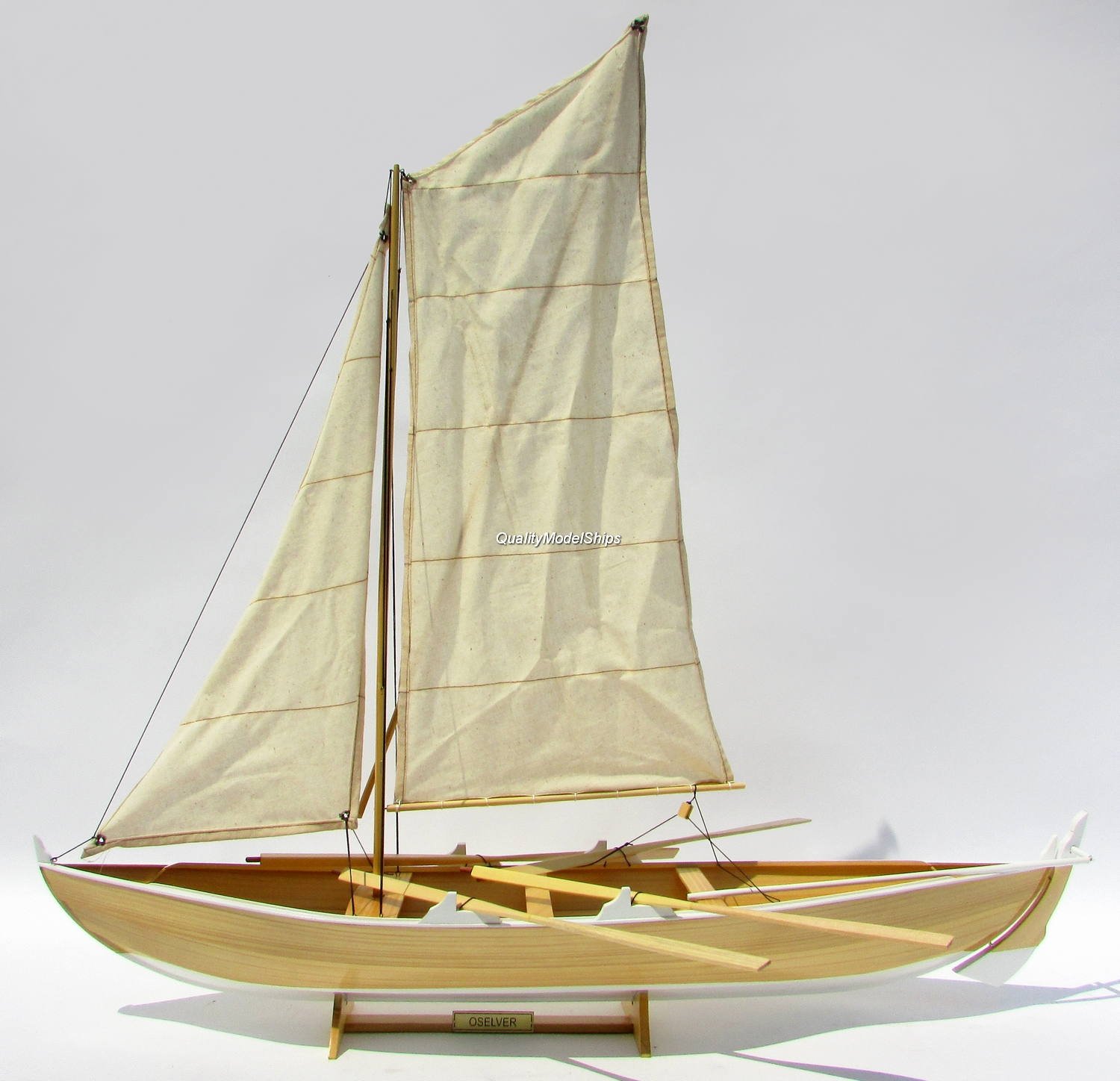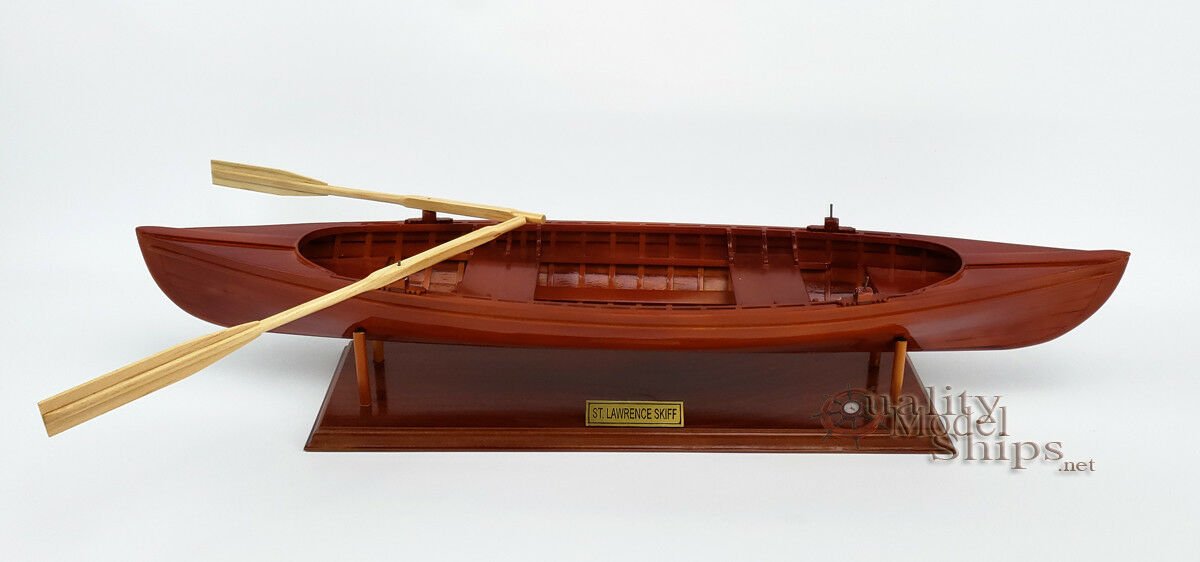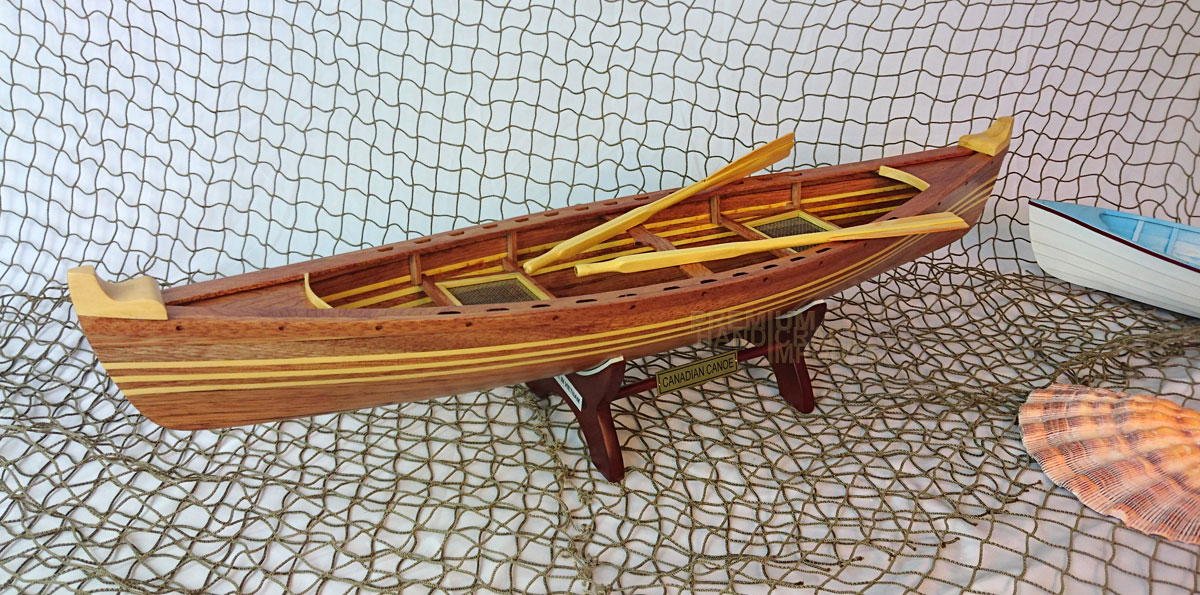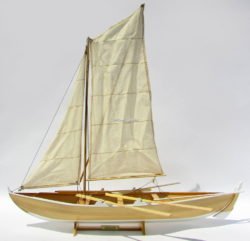| Content | • The model is 100% scratch built with planks-on-frame construction method. The hull is made of wood and painted. The mast is pre-assembled during the rigging process, then removed and fold flat down to minimize the shipping cost. It takes around 5 minutes to assembled the mast.
• Model included the base with the brass nameplate as show photos.
• Dimensions approximate 28.35L x 7.87W x 17.71H (inch) or 72L x 20W x 45H (cm)
• Condition: brand new product.
• Buyer from Alaska, Puerto Rico or Hawaii please contact us for extra shipping cost
• Oversea buyer pays any import taxes/ duties.
• Returned or exchanged products must be in brand-new, original condition, and have all original packaging, materials, and accessories .
• Buyer pays return shipping.
HISTORY
African Queen (also known as S/L Livingstone) was the name of two boats used in the 1951 movie The African Queen starring Humprey Bogart and Katharine Hepburn. It was filmed in the Belgian Congo on a tributary of the Congo River, and on the Nile in the Murchison Falls National Park in Uganda. Two boats were utilised, one in each location. One of the boats is now located in Key Largo, Florida and on February 18, 1992, was added to the U.S. National Register of Historic Places. The other is located in Jinja, Uganda.
The Congo boat
This African Queen was a 30-foot steam boat built of riveted sheet iron in 1912 in the United Kingdom for service in Africa on the Victoria Nile and Lake Albert where the movie was filmed in 1950. Originally named Livingstone, she was built for the British East Africa Railway and used from 1912 to 1968. It spent most of its first 50 years operating in the waters of the Ruki River in the northern Democratic Republic of Congo where she was used to transport hunters, mercenaries, and cargo.
According to an article on its 2012 restoration, it was built by Lytham Shipbuilding and Engineering Co., as evidenced by the boiler plate and Lancashire records.
The boat was found in Cairo, Egypt in the 1970s, with coal still in its bilges. Purchased and shipped to the United States, it has had a succession of owners and is currently held in trust. It was refurbished in 2012, including installation of an interior steel hull frame and new boiler, and restored to service as a tourist boat.
The Nile boat
The other African Queen was built in 1950 for the film purposes and was discovered by Yank Evans, a Patagonian mechanical engineer who'd come across what was left of the vessel while working on the roads in Murchison Falls National Park, Uganda in 1984. "Yank came across a carcass of a steel boat, in the bushes there just left to rot. He asked the locals what this was and they said well that's the African Queen. So he bought it off the National Parks for $1." Evans, who'd worked on the boat with his son Billy and gave her a steam engine then stored the boat when he moved to Kenya in 1997 and her new home became a trailer in the garden.
Cam McLeay, a Kiwi who lived in Uganda for ten years with his family, purchased the Nile African Queen after hearing her story and set to finishing the restorations and getting the boat's original steam engine functioning and in the water. McLeay and his team rebuilt the African Queen's century-old Brady steam engine and replating the hull and replacing over 100 pipes, sourcing parts mostly from the UK but also from within Uganda. | • The model is 100% scratch built with planks on frame construction by our master craftsmen. The model is built with all natural wood finished. Model comes with two pair of oars and a brass name plate on the base like shown photos.
• Dimensions approximate 23.62L x 6.29W x 6.69H (inch) or 60L x 16W x 17H (cm)
• Condition: brand new product.
• Item will be shipped by USPS/ FedEx ground to 48 lower states. Please contact us if your are in Hawaii, Alaska or Puerto Rico for extra shipping cost.
• International buyer pays any duty/ import tax.
Return/ Exchange Policy
• For some reasons if you wish to return the item, please consider not to open the item out of the wooden crate or open the item out of the styrofoam. You can open the carton box, lift up the whole wooden crate and check the models that are packed in wooden crate. For the items are packed in solid styrofoam, you can open the carton box, lift up the top part (styrofoam lid) and check the model. Please do not cut any strips or take the model out of the wooden crate or out of the styrofoam. It is very risky of damages to the item when you return if you open or remove the item out of the wooden crate or the styrofoam. We only accept and refund in full when the model return in good shape.
• Returned or exchanged products must be in brand-new, original condition, and have all original packaging, materials, and accessories .
• Buyer pays return shipping.
• 15% restocking fee might apply.
| • The model is 100% scratch built with clinker hull construction method by master craftsmen. The hull is made of pine wood as the original real boat. Model comes with 2 pair of oars, a display base like shown photos. The mast fold flat down to minimize the shipping cost and it takes around 5 minutes to assemble the mast.
• Dimensions approximate 30.70L x 7.48W x 23.62H (inch) or 78L x 19W x 60H (cm)
• Condition: brand new product.
• Buyer from Alaska, Puerto Rico, Hawaii or overseas, please contact us for shipping cost.
• Item ship from Houston Texas by Standard shipping USPS/ UPS/ FedEx ground
• International buyer pays any duty/ import tax if any. | • The model is 100% scratch built with planks on frame construction
method from the drawings. The hull is made of wood and black painted like the real boat.
• This model is not a kit and ready for display. Model comes with a display base and a brass nameplate as shown photos.
• Specifications: 23.6L x
5.90W x 7.08H (inch) or 60L x 15W x 18H (cm)
• Brand new product
• Buyer from Alaska, Puerto Rico or Hawaii, please contact us for extra shipping cost.
• Item ship from Houston Texas by Standard shipping USPS/ UPS/ FedEx ground
• International buyer pays any duty/ import tax if any.
| • The model is 100% scratch built with planks-on-frame construction method by master craftsmen. The building of this model is exactly like building the full size canoe but the only different thing this is a scale model. The hull is made of wood, the inside hull is constructed with ribs and seats as the original boat. Model comes with oar locks, a pair of oars and a brass name plate on the base like shown photos.
• Dimensions approximate 25.2L x 5.11W x 3.93H (inch) or 60L x 13W x 10H (cm)
• Condition: brand new product.
• Buyer from Alaska, Puerto Rico or Hawaii please contact us for extra shipping cost.
• International buyer pays any duty/ import tax.
| • The model is 100% scratch built with strips of wood by master craftsmen. Model comes with a pair of oars and a brass name plate on the base like shown photos.
• Dimensions approximate 23.62"L x 4.72"W x 5.90"H or 60L x 12W x 15H (cm)
• Condition: brand new product.
• Item will be shipped by UPS/ FedEx ground to 48 lower states. Please contact us if your are in Hawaii, Alaska or Puerto Rico for extra shipping cost.
• International buyer pays any duty/ import tax.
Return/ Exchange Policy
• For some reasons if you wish to return the item, please consider not to open the item out of the wooden crate or open the item out of the styrofoam. You can open the carton box, lift up the whole wooden crate and check the models that are packed in wooden crate. For the items are packed in solid styrofoam, you can open the carton box, lift up the top part (styrofoam lid) and check the model. Please do not cut any strips or take the model out of the wooden crate or out of the styrofoam. It is very risky of damages to the item when you return if you open or remove the item out of the wooden crate or the styrofoam. We only accept and refund in full when the model return in good shape.
• Returned or exchanged products must be in brand-new, original condition, and have all original packaging, materials, and accessories .
• Buyer pays return shipping.
• 15% restocking fee might apply.
|
